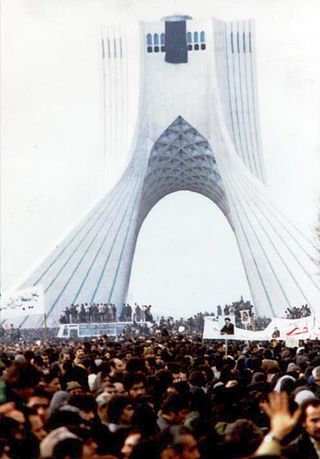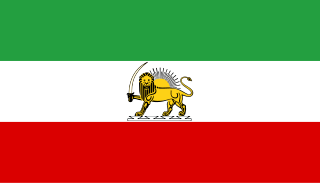
Ruhollah Musavi Khomeini was an Iranian Islamic revolutionary, politician and religious leader who served as the first supreme leader of Iran from 1979 until his death in 1989. He was the founder of the Islamic Republic of Iran and the main leader of the Iranian revolution, which overthrew Mohammad Reza Pahlavi and ended the Iranian monarchy. Ideologically a Shia Islamist, Khomeini's religious and political ideas are known as Khomeinism.

The Bureau for Intelligence and Security of the State, shortened to as SAVAK or S.A.V.A.K. was the secret police of the Imperial State of Iran. It was established in Tehran in 1957 and continued to operate until the Islamic Revolution in 1979, when it was dissolved by Iranian prime minister Shapour Bakhtiar.

The Iranian revolution, also known as the 1979 revolution, or the Islamic revolution of 1979 was a series of events that culminated in the overthrow of the Pahlavi dynasty in 1979. The revolution led to the replacement of the Imperial State of Iran by the present-day Islamic Republic of Iran, as the monarchical government of Mohammad Reza Pahlavi was superseded by the theocratic Ayatollah Ruhollah Khomeini, a religious cleric who had headed one of the rebel factions. The ousting of Pahlavi, the last Shah of Iran, formally marked the end of Iran's historical monarchy.
Ettela'at is a Persian-language daily newspaper of record published in Tehran, Iran. It is among the oldest publications in the country, and the oldest running Persian daily newspaper in the world. The paper has a conservative stance, and focuses on political, cultural, social, and economic news. Until the 1979 Iranian Revolution, the newspaper was associated with its chief founder Abbas Massoudi (1895–1974).

Cultural Foundation of Refah was an elementary school for girls in Tehran, Iran. It gained historical significance in the 1979 Iranian Revolution when it was the temporary headquarters of the revolutionists led by Ruhollah Khomeini. It was also used for the Islamic Revolutionary Court and the execution of officials of the second Pahlavi Regime on its rooftop before being transformed into what is being currently used as, a cultural and educational institution.

This article is a timeline of events relevant to the Islamic Revolution in Iran. For earlier events refer to Pahlavi dynasty and for later ones refer to History of the Islamic Republic of Iran. This article doesn't include the reasons of the events and further information is available in Islamic revolution of Iran.

Mohammad Reza Pahlavi, commonly referred to in the Western world as Mohammad Reza Shah, or simply the Shah, was the last monarch of Iran (Persia). In 1941 he succeeded his father Reza Shah and ruled the Imperial State of Iran until 1979 when the Iranian Revolution overthrew him, abolished the monarchy and established the Islamic Republic of Iran. In 1967, he took the title Shahanshah, and also held several others, including Aryamehr and Bozorg Arteshtaran. He was the second and last ruling monarch of the Pahlavi dynasty. His vision of the "Great Civilization" led to his leadership over rapid industrial and military modernization, as well as economic and social reforms in Iran.

Iranian monarchism is the advocacy of restoring the monarchy in Iran, which was abolished after the 1979 Revolution.

Casualties of the Iranian revolution refers to those who lost their lives during the Iranian revolution. Observers differ on how many people died during the Iranian revolution. The current Islamic government uses the figure of 60,000 killed; in reference to this figure, the military historian Spencer C. Tucker notes that "Khomeini's regime grossly overstated the revolution's death toll for propaganda purposes". The sociologist Charles Kurzman, drawing on later more detailed records from the Islamic Republic, believes the number was closer to 2,000-3,000.
Following the Iranian revolution, which overthrew the Shah of Iran in February 1979, was in a "revolutionary crisis mode" from this time until 1982 or 1983 when forces loyal to the revolution's leader, Ayatollah Ruhollah Khomeini, consolidated power. During this period, Iran's economy and the apparatus of government collapsed; its military and security forces were in disarray.
The Imperial State of Iran, the government of Iran during the Pahlavi dynasty, lasted from 1925 to 1979. During that time two monarchs — Reza Shah Pahlavi and his son Mohammad Reza Shah Pahlavi — employed secret police, torture, and executions to stifle political dissent. The Pahlavi dynasty has sometimes been described as a "royal dictatorship", or "one-man rule". According to one history of the use of torture by the state in Iran, abuse of prisoners varied at times during the Pahlavi reign.

The Iranian revolution was the Shia Islamic revolution that replaced the secular monarchy of Shah Mohammad Reza Pahlavi with a theocratic Islamic Republic led by Ayatollah Ruhollah Khomeini.

The Imperial State of Iran, officially known in English as the Imperial State of Persia until 1935, and commonly referred to as Pahlavi Iran, was the Iranian state under the rule of the Pahlavi dynasty. The Pahlavi dynasty was created in 1925 and lasted until 1979, when it was ousted as part of the Islamic Revolution, which ended the Iranian monarchy and established the current Islamic Republic of Iran.

Ruhollah Khomeini’s return to Iran on 1 February 1979, after 14 years in exile, was an important event in the Iranian Revolution. It led to the collapse of the provisional government of Shapour Bakhtiar and the final overthrow of the Shah of Iran, Mohammad Reza Pahlavi, on 11 February 1979.

"Island of Stability" is a phrase that became the namesake for a 1977 speech by American president Jimmy Carter, while he was being hosted by Mohammad Reza Pahlavi at the Niavaran Complex in Tehran, Iran. It was a reflection of Iran's circumstances — regarded as a stable country and a bastion of the Western Bloc in what was otherwise an unstable Middle East under the influence of the Eastern Bloc — and the importance placed on the Shah's rule by the United States. Carter's speech was made one year before the Islamic Revolution overthrew the Pahlavi dynasty and replaced it with the Islamic Republic.
"Iran and Red and Black Colonization" was an article written by "Ahmad Rashidi Motlagh" published in Ettela'at newspaper on 7 January 1978. The article was used to attack Ruhollah Khomeini, who later founded the Islamic Republic of Iran. It led to the 1978 Qom protest.

This is a timeline of the Iran hostage crisis (1979–1981), starting from the Shah Mohammed Reza Pahlavi's leaving of Iran and ending at the return of all hostages to the United States.

In 2016, the BBC published a report which stated that the administration of United States President Jimmy Carter (1977–1981) had extensive contact with Ayatollah Ruhollah Khomeini and his entourage in the prelude to the Iranian Revolution of 1979. The report was based on "newly declassified US diplomatic cables". According to the report, as mentioned by The Guardian, Khomeini "went to great lengths to ensure the Americans would not jeopardise his plans to return to Iran - and even personally wrote to US officials" and assured them not to worry about their interests in Iran, particularly oil. According to the report, in turn, Carter and his administration helped Khomeini and made sure that the Imperial Iranian army would not launch a military coup.

Shia Islamism is the usage of Shia Islam in politics. Most study and reporting on Islamism has been focused on Sunni Islamist movements. Shia Islamism, a previously very small ideology, gained in popularity after the Iranian Revolution led by Ruhollah Khomeini, whose Shia Islamist policies became known as Khomeinism. However, there are also Shia Islamist movements outside of Khomeinism, such as the Islamic Dawa Party of Muhammad Baqir al-Sadr and the Sadrist Movement of Muqtada al-Sadr.

This article deals with people's slogans during the 1979 Iranian revolution.













